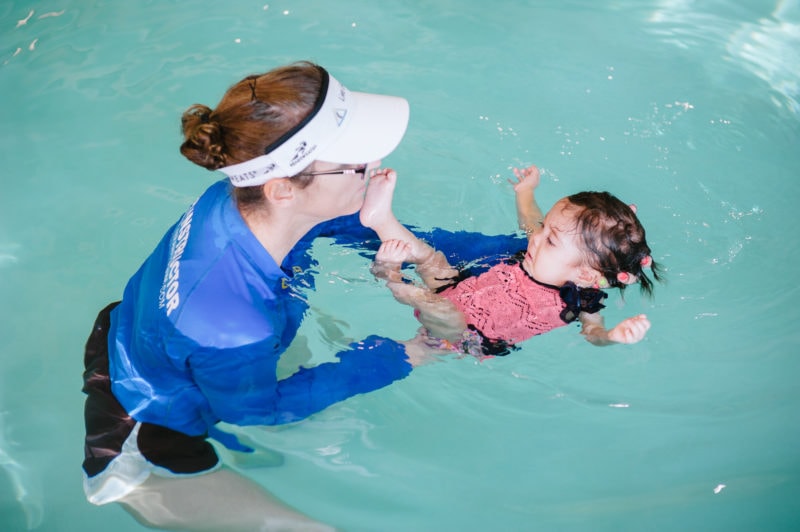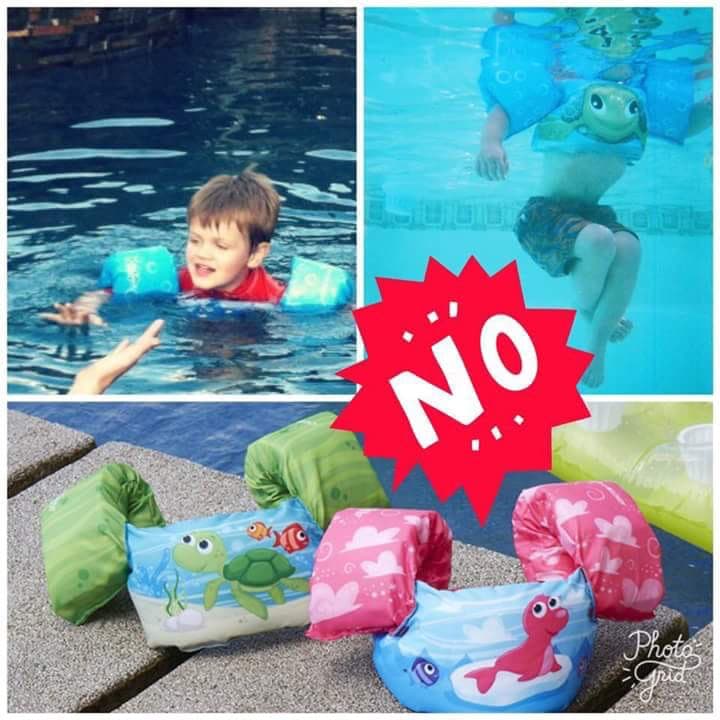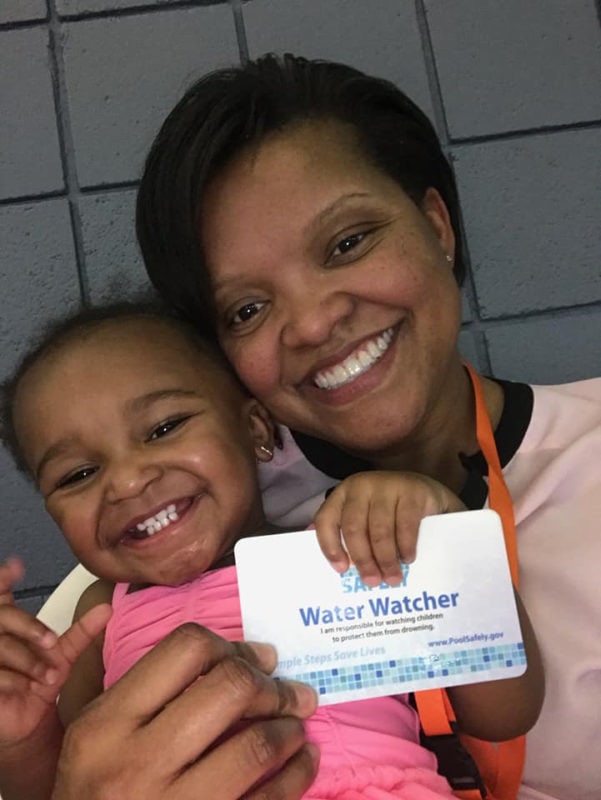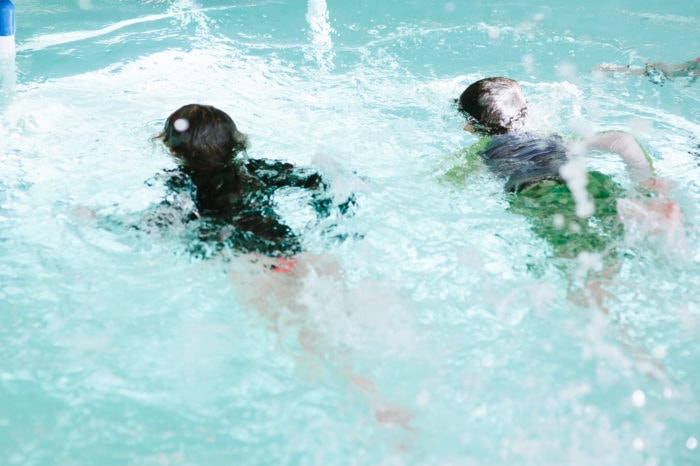By Guest Blogger Darlene Haskins
With summer approaching, knowing how to keep kids safe in and around water is essential for parents and caregivers. We like to believe the unthinkable could never happen on our watch, but the staggering statistics show that drowning accidents happen to families like you and me every day. According to the CDC, about 4,000 people drown in the U.S. yearly; drowning kills more children ages one to four than anything except birth defects.
Whether you’re headed to the beach or hanging out at the pool, a multi-layered approach is the best way to protect your family.
The layers of protection for water safety are:
1. Practice effective adult supervision. Despite what the movies show, drowning is quick and silent. Always know where your children are, avoid distractions like phones and socializing, and take turns having an adult as the exclusive Water Watcher responsible for nothing else but watching the children.
2. Install barriers. It is important to have all doors and windows locked and alarmed. If you own a pool, install a permanent four-sided fence with self-locking gates, and ensure the fence is at least three to five feet from the pool edge.
 3. Enroll in survival swim lessons. All adults and children should have the ability to swim. Children as young as six months old can learn to float on their backs. The best swim training consists of one-on-one lessons with a certified instructor that teaches children to first float to save themselves if they are ever in a near-drowning situation.
3. Enroll in survival swim lessons. All adults and children should have the ability to swim. Children as young as six months old can learn to float on their backs. The best swim training consists of one-on-one lessons with a certified instructor that teaches children to first float to save themselves if they are ever in a near-drowning situation.
4. Know CPR. If an emergency does occur, it is essential that parents and families are prepared. Learn to perform CPR on children and adults, and update those skills regularly.
Here are a few additional tips for water safety:
 • Refrain from putting children in “floaties”. Despite their popularity, flotation devices, including puddle jumpers, arm bands, inflatable rings, rafts, and noodles, give kids a false sense of swimming abilities and cause children to float in a vertical position, falsely teaching them that this position allows them to maintain buoyancy and get air – the exact opposite of a lifesaving back-float position.
• Refrain from putting children in “floaties”. Despite their popularity, flotation devices, including puddle jumpers, arm bands, inflatable rings, rafts, and noodles, give kids a false sense of swimming abilities and cause children to float in a vertical position, falsely teaching them that this position allows them to maintain buoyancy and get air – the exact opposite of a lifesaving back-float position.
• Get in with your kids! Remember that having a parent or caregiver in the water is the safest way to play. As an added bonus, interacting together allows the parent and child essential time to connect. Even adults should always swim with a buddy.
• Use dive toys. Sinking toys (rings, sticks, etc.) encourage children to use the proper horizontal, head-down posture.
• Wear bright colored swimwear. Brighter suits (neon pink, yellow, orange, red) are more likely to be seen beneath the water’s surface. Avoid blue, purple, green, and darker colors which are difficult to see.
 • Let your child swim without goggles. Should a child accustomed to swimming only in goggles find themselves in the water without them, they are more likely to panic and keep their eyes closed.
• Let your child swim without goggles. Should a child accustomed to swimming only in goggles find themselves in the water without them, they are more likely to panic and keep their eyes closed.
• Pick the correct snorkel. Not all are made equal. Ensure snorkels have safety guards on both top and bottom of the breather, and make sure the size is right for the child’s mouth and face.
• Test life jackets. With your child in the vest, check that they will be turned to their back to float face up. Many life jackets, even some Coast Guard approved, do not differentiate which way they float the child, meaning they could leave them floating face down in the water. Life jackets should not be worn for daily swimming due to the concerns about floatation devices listed above, but they should be used on boats or open water.
• Pull long hair up. In addition to getting caught in drains, it may get in the swimmer’s face and cause difficulty seeing.
• Teach kids how to get around the pool. When visiting pools with children, familiarize them with their environment by going around the edges (including both shallow and deep ends) and showing them how to grab and “walk” on the wall to make their way to a ladder or stairs.
Lastly, but certainly not least, know how much water is within a one mile radius of your home and places you frequent (daycare, preschool, church, grandparents). Search Google Maps for nearby water hazards. Remember how easily children can slip out of sight and take precautionary measures as listed in the four Layers of Protection above.
Upcoming Event:
Community Water Safety Day
Town of Kernersville
134 E Mountain St
Kernersville, North Carolina 27284
May 18, 2019
10AM – 2PM
Want to see more blogs like this and get notifications on local events and happenings? Subscribe to our free weekly newsletters here.

















I want to say that Darleen is doing great work on the front lines of drowning prevention. Her information she shares not to mention her ISR (Infant Swim Resource), teaching the children as early as 6 months old will save lives. I would say if what she does was available to us 25 years ago my daughter Kelsey would still be here today. She would have been able to roll over & float till she would of been noticed. However she drowned 8 feet away from a lifeguard while in the care of her babysitter. The systems, knowledge along with technology is available to make a difference today. She is an expert in the area of water safety and drowning prevention.
I will be in attendance at her Water Safety Day in Kernersville N.C. To all who can make it. Let’s get out and show our support for what she is doing.
Thanks again for the opportunity to share this important information!